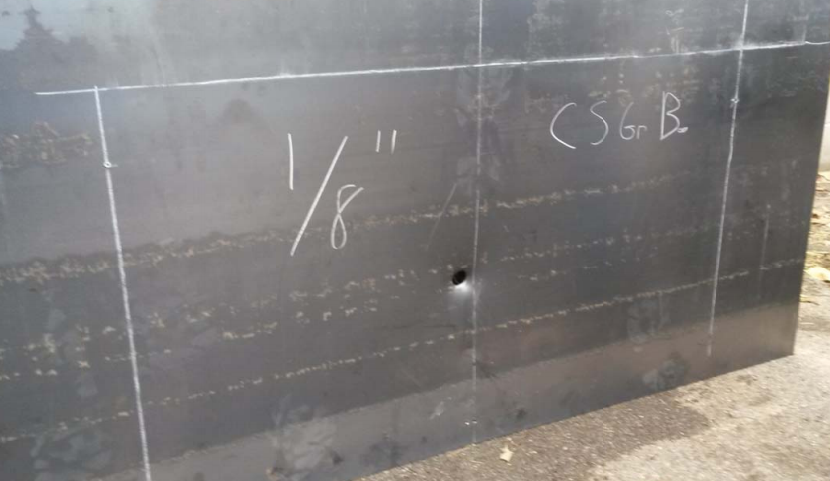The calculators used on this page are based on the equations from BC-TOP-9A. Where applicable, we have referenced the corresponding equation in the Bechtel Report.
These calculators are very useful for preliminary sizing, or determining if failure will occur. Please note that there are limits of applicability, and we recommend reviewing the Bechtel Report in detail before using the equations in design.
Concrete Missile Barriers
When designing concrete missile barriers, the designer needs to take perforation into account, as well as spalling on the back side of the concrete. The pieces of spalled concrete can be going very fast, and can still cause damage, so it’s important to size concrete barriers properly.
Equation 2-3 of BC-TOP-9A:
[latexpage]
\[
T=\frac{427}{\sqrt{f’_c}}*\frac{W}{D^{1.8}}*\left \{ \frac{V_s}{1000} \right \}^{1.33}
\]
Where
$T$ = Thickness to just prevent perforation (inches)
$f’_c$ = Concrete compressive strength (psi)
$W$ = Missile Weight (lb)
$D$ = Missile Diameter (inches)
$V_s$ = Missile striking velocity (ft/s)
It’s recommended to increase the thickness T by 25%, but no more than 10 inches. To prevent spalling, it’s recommended to increase thickness by 100% (2T). To ensure sufficient margin, It’s also recommended to increase this value by 25%.
Use the calculator below to determine the minimum required concrete thickness to prevent perforation.
[CP_CALCULATED_FIELDS id=”7″]
Steel Missile Barriers
Ballistic Research Laboratory (BRL)
The Ballistic Research Laboratory (BRL) formula is shown below. This formula calculates the required thickness that will just cause perforation. Plate must be thicker than this to prevent perforation!
Equation 2-7 of BC-TOP-9A:
\[
T=\frac {\left \{ \frac{W*V_s^{2}}{2*32.2} \right \}^{\frac{2}{3}}}{672*D}
\]
Where
$T$ = Plate Thickness to just prevent perforation (inches)
$W$ = Missile Weight (lb)**
$D$ = Missile Diameter (inches)
$V_s$ = Missile striking velocity (ft/s)
**=BC-TOP-9A gives the equation based on missile mass. This formula corrects it for missile weight.
It’s recommended to increase this thickness by 25% to provide margin against penetration.
Stanford Research Institute
Stanford Research Institute gives the following equation for steel target thickness.
Equation C-11, rearranged for T (also equation C-13):
\[
T=\sqrt{0.045*\frac{W_m*V_s^2}{DS}+0.0022*\frac{W}{W_s}^2}-\frac{W}{W_s}
\]
Where
$T$ = Plate Thickness to just prevent perforation
$W_m$ = Weight of the missile in lb
$W_s$ = Length of standard width (4in)
$W$ = Length of square side between rigid supports (in)
$V_s$ = Missile striking velocity in ft/s
$S$ = Ultimate tensile strength of the target minus the tensile stress (psi)
[CP_CALCULATED_FIELDS id=”8″]

